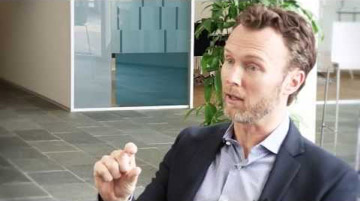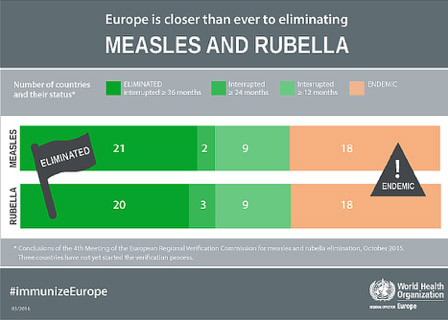Most countries in the European region have officially eliminated measles and rubella, according to the WHO’s Regional Officer for Europe – but others need to catch up.
The pace of progress has picked up over the past 24 months, according to Robb Butler, Programme Manager, Vaccines and Immunization at WHO offices in Copenhagen.
“The data show 32 of the 53 countries in the WHO European Region have interrupted transmission of measles and the picture for 2015 looks even better,” Butler told Vaccines Today. “If fact, when the final figures are verified, we could find that the 2015-2016 measles season saw the lowest number of measles cases in a decade.”

This comes after warnings that progress was slow in 2012 and 2013. Calls for greater political commitment appear to have been heeded by some countries.
Despite pressures from a range of competing health and social policy challenges, a number of governments have taken concrete steps to tackle measles, using detailed disease surveillance data to target campaigns at those most at risk.
Italy is planning a catch-up campaign for adolescents who may have missed out on childhood measles vaccination; Greece is about to launch immunisation campaigns for migrant communities; and Germany has published a 2015-2020 Action Plan for measles elimination which could set the tone for other northern and western European countries where measles is still endemic.
Closing the gap
Still, there are gaps. Seventeen countries continue to deal with regular measles outbreaks while three do not have robust surveillance systems for rubella to help them figure out how best to target those at risk.
“There is a lot of positive momentum,” says Butler. “But we still have some countries that have to catch up; that need to get the basics right if they are to get across the line.”
The WHO has published its measles/rubella elimination verification data which effectively shows how countries rank compared to others in the region. The system makes good reading for high achievers, highlights shortcomings and offers potential to pair peers so that they can learn from one another’s experience.
So what do measles-free countries have in common? Strong surveillance systems, a government willing to respond to data with tailored campaigns, and a commitment to maintaining high coverage rates – between 90% and 95% because measles is highly infectious.

Turning the tide
Butler senses that the tide may be turning in terms of public appreciation of the value of vaccination against measles and rubella.
“Over the last 24 months we have seen a different narrative around measles and rubella. It has become less and less acceptable to see children hospitalised or lose their lives to a vaccine-preventable disease in the European region.
However, he believes more could be done to communicate how difficult it is to eliminate a highly infectious disease such as measles, and to drive home the broader benefits of vaccination.
“The broader value of vaccination is not being communicated. We’re not explaining to communities, healthcare workers and decision-makers that vaccines also make a big contribution to gender equity, to prolonging life, and to the breakdown of social economic barriers,” Butler says.
“You could even say that by vaccinating today we are allowing people to travel more easily, to be more mobile, and to be safer while we’re doing it.”
Achieving the high level of immunisation requires to rid Europe of measles is far from easy but there is a growing sense that it is achievable. Even the very small minority of vocal anti-vaccine activities are not a barrier provided the wider population plays its part.
“There will always be some who oppose but quite frankly I don’t believe they are substantial or credible enough to prevent elimination of measles and rubella in Europe. It would be a mistake to focus on them. We can get across the line and eliminate these diseases if we have the right level of political commitment and we do all of the things that we know work.”
Member States of the WHO European Region by measles and rubella elimination status in 2014
| Countries by measles elimination status, 2014 | Countries by rubella elimination status, 2014 | |
| Interrupted (no longer spreading) | 32 | 32 |
| Endemic (Regularly reported) | 18* | 18* |
| Annual Status Update not submitted | 3 | 3 |
| *Unofficial version of ASU for 2014 received from Ukraine; RVC made decision based on NVC’s documents from previous years and information from other official sources | ||
Member States of the WHO European Region with endemic transmission of measles, rubella or both diseases in 2014
| Countries | |
| Endemic transmission of measles and rubella | Austria, Belgium, Bosnia and Herzegovina, France, Georgia, Germany, Italy, Kazakhstan, Kyrgyzstan, Poland, Romania, Serbia, Switzerland, The Russian Federation, Turkey, Ukraine* |
| Endemic transmission of rubella | Bulgaria, Denmark |
| Endemic transmission of measles | Ireland, the former Yugoslav Republic of Macedonia |




